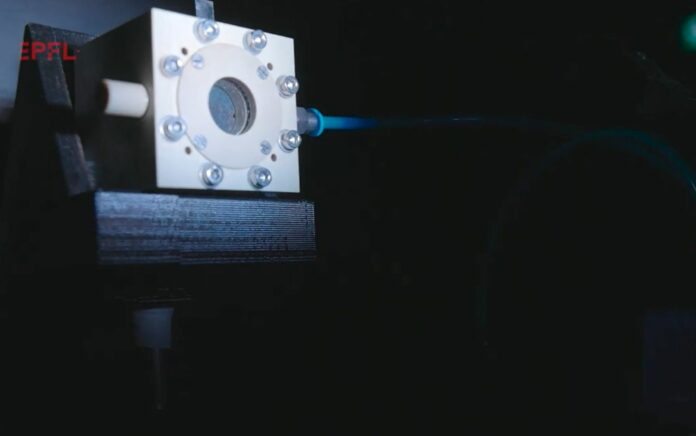For decades, researchers have wished for a technology that can gather water from the air and create hydrogen fuel while being totally driven by solar energy.
Kevin Sivula, an EPFL chemical engineer, and his colleagues have taken an important step in making this vision a reality.
They have come up with a clever and easy-to-use system that combines semiconductor technology with new electrodes that have two important qualities: they are porous so that they can make the most contact with water in the air, and they are transparent so that the semiconductor coating can get the most sunlight. Simply exposing the gadget to sunlight causes it to absorb water vapor from the atmosphere and transform it into hydrogen gas.
The findings were published in Advanced Materials today.
Is there anything new? Their innovative, transparent, porous, and conductive gas diffusion electrodes are what make it possible for this solar-powered technology to convert water—in its gaseous condition from the air—into hydrogen fuel.
“To realize a sustainable society,” according to principal investigator Sivula, “we need ways to store renewable energy as chemicals that can be used as fuels and feedstocks in industry. Solar energy is the most abundant form of renewable energy, and we are striving to develop economically-competitive ways to produce solar fuels.”
Inspiration derived from a leaf
The EPFL engineers, working with Toyota Motor Europe, were inspired by how plants use carbon dioxide from the atmosphere to transform sunlight into chemical energy while conducting their study on sustainable fossil-free fuels.
A plant takes carbon dioxide and water from its surroundings and, with the help of sunlight, converts these molecules into sugars and starches, a process known as photosynthesis. The energy of the sun is stored in the sugars and starches as chemical bonds.
When covered with a light-harvesting semiconductor material, the transparent gas diffusion electrodes created by Sivula and his colleagues do indeed operate like an artificial leaf, collecting water from the atmosphere and sunlight to make hydrogen gas. The energy from sunshine is stored as hydrogen bonds.
Instead of using standard layers that are opaque to sunlight to construct electrodes, they use a 3-dimensional mesh of felted glass fibers.
“Developing our prototype device was challenging since transparent gas-diffusion electrodes have not been previously demonstrated, and we had to develop new procedures for each step,” explains lead author Marina Caretti.
“However, since each step is relatively simple and scalable, I think that our approach will open new horizons for a wide range of applications starting from gas diffusion substrates for solar-driven hydrogen production.”
From liquid water to air humidity
Using a device known as a photoelectrochemical (PEC) cell, Sivula and other research teams have already shown that it is feasible to accomplish artificial photosynthesis by creating hydrogen fuel from liquid water and sunlight.
A PEC cell is often thought of as a system that activates a photosensitive substance, such as a semiconductor, submerged in a liquid solution to trigger a chemical reaction.
However, there are several practical drawbacks to this method, such as the difficulty in producing liquid-based large-area PEC devices.
Sivula developed a novel gas diffusion electrode to demonstrate how the PEC technology may be modified to extract humidity from the air instead.
Although it has been shown that electrochemical cells (such as fuel cells) may operate with gases rather than liquids, the gas diffusion electrodes used in those earlier experiments are opaque and unsuitable for solar-powered PEC technology.
The researchers are now concentrating their efforts on system optimization.
What size of fiber is ideal? How big should pores be? The optimal membrane materials and semiconductors?
This is the focus of the EU Project “Sun-to-X,” which is devoted to advancing this technology and developing novel methods for converting hydrogen into liquid fuels.
Transparent gas-diffusion electrodes
To create transparent gas diffusion electrodes, researchers begin with a sort of glass wool, which is basically quartz (also known as silicon oxide) fibers, then fuse the fibers together at a high temperature to create felt wafers.
The wafer is then covered with a clear, thin layer of fluorine-doped tin oxide, a material renowned for its superior conductivity, durability, and scalability.
The result of these first steps is a wafer that is clear, has holes, and conducts electricity. This is important for making the most contact with the water molecules in the air and letting photons pass through.
The wafer is subsequently covered once again, this time with a thin sheet of semiconductor materials that absorb sunlight. The vast surface area of the porous substrate gives this second thin covering the appearance of being opaque while yet allowing light to pass through.
This coated wafer can already make hydrogen fuel when it is put out in the sun.
The scientists next constructed a tiny chamber holding the covered wafer and a membrane for separating and measuring the created hydrogen gas.
The scientists’ chamber produces hydrogen gas when exposed to sunshine and moisture, meeting their goal and demonstrating that the idea of a transparent gas- diffusion electrode for solar-powered hydrogen gas generation is possible.
While the scientists did not explicitly examine the solar-to-hydrogen conversion efficiency in their presentation, they admit that it is modest for this prototype and presently lower than that of liquid-based PEC cells.
The coated wafer’s highest potential solar-to-hydrogen conversion efficiency is 12% based on the materials utilized, compared to up to 19% for liquid cells.
Source: 10.1002/adma.202208740
